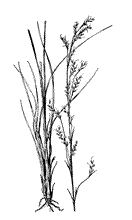-
MLDP:
- Managed Lands Deer Program
Panhandle Wildlife Management
Conservation Issues Of Shortgrass Prairie
By Robert Sullivan and Matt Wagner

Approximately 16 million acres of native short grass and mixed grass prairie currently exist in the Texas panhandle. These native prairies provide important habitat to a variety of resident and migratory wildlife. Some of the more visible species include black-tailed prairie dogs Cynomys ludovicianus, pronghorn antelope Antilocapra americana, and bald eagles Haliaeetus leucocephalus while others like the swift fox Vulpes velox, mountain plover Charadrius montanus, and lesser prairie-chicken Tympanuchus pallidicinctus are more secretive and require more effort to observe.
During the past 100 years more than half of the native prairies in Texas have been lost to urban development or converted to cropland. Loss of habitat has caused concern about some of the prairie-dependent species like the swift fox and mountain plover. In addition to the many biologists currently working in the panhandle, Parks and Wildlife has initiated a project working with local landowners to develop conservation strategies for rare species of the short grass prairie ecosystem. Because 97 percent of the land in Texas is privately owned, success the project depends upon development of conservation strategies compatible with farming and ranching.
Agriculture and RanchingMuch majority of the Rolling Red Plains has been altered for agriculture, primarily ranching. Remaining natural communities are affected by fragmentation, direct loss to pasture, and overgrazing. Conservation efforts in the area will require strong cooperation with private non-industrial landowners to provide increased incentives for riparian zone restoration, oak motte restoration and management, and increased management of natural grassland systems. Much of this area is used for ranching and thus remains in relatively good condition to support native bird populations; however, conversion to agriculture and use of circle-pivot irrigation is taking its toll, particularly in eastern portions. A careful grazing regime with some rest and rotation that allows moderate fuel buildup for occasional fires will provide longterm benefit both to the rancher and the birds. Prairie dog towns, greatly diminished, provide conditions preferred by some priority birds. The shrubland component used by some of the highest priority birds, including the Lesser Prairie-Chicken, should no longer be eliminated through herbicide treatment. Lesser Prairie-Chicken management needs to be aggressive to halt the decline of this rare bird. Native rangeland surrounding lek sites must be retained and grazing managed to create conditions required by the birds. Ephemeral playas and non-riparian wetlands are unique features of this physiographic area in which grazing and water level management can benefit many birds. Termination of residual pesticide run-off, dumping of oil and gas waste by-products and disruption of clay bottoms for the creation of more permanent water sources will maintain playa conditions needed by birds.
RestorationGrassland restoration in Texas is rapidly becoming a priority for private landowners. The Texas Parks and Wildlife Department also has two ongoing prairie restoration projects in the Panhandle district. Rita Blanca National Grasslands in Dallam County and Copper Breaks State Park in Hardemann County. These areas provide examples of fully restored grasslands and support populations of indigenous wildlife such as black-tailed prairie dogs and ferruginous hawks.
Contact your county wildlife biologist for additional information on prairie restoration.